Promoting Comprehensive Electrification to Achieve Carbon Neutrality
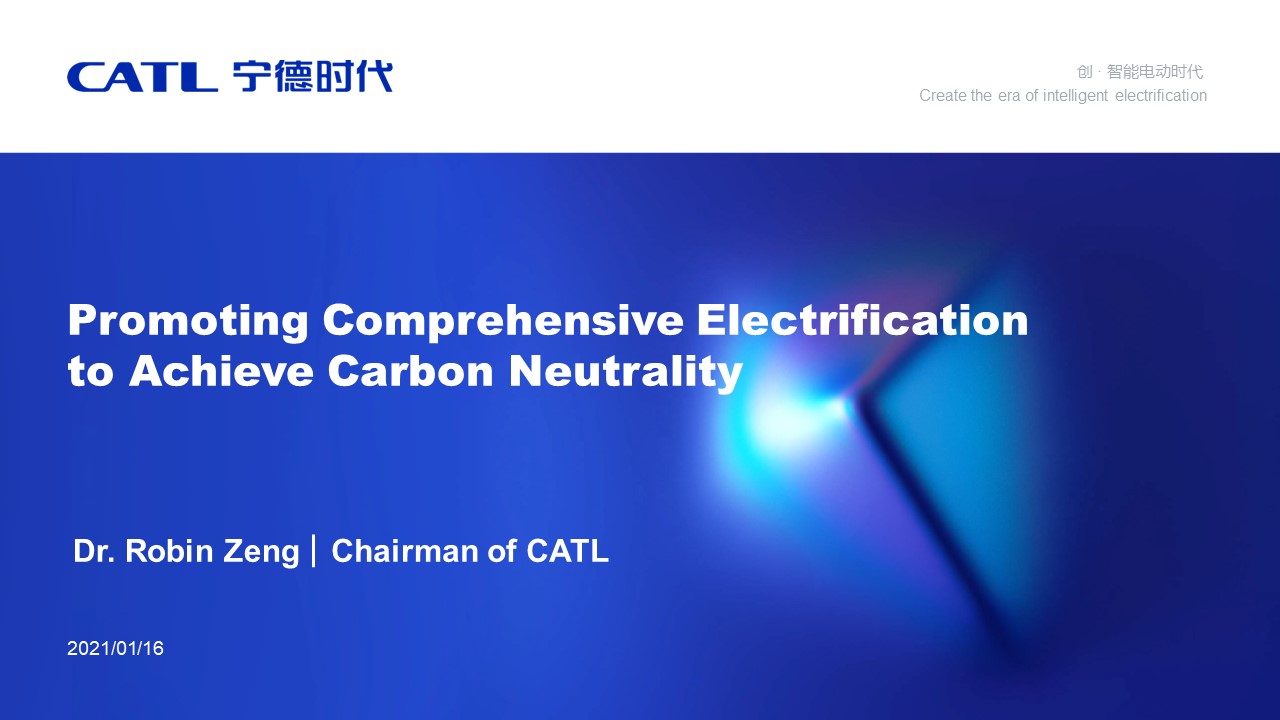
The speech of Robin Zeng, founder and chairman of CATL, during the China EV100 Forum(2021)
It's my honor to once again participate in the China EV100 Forum. The insightful views on the EV industry shared by previous experts and scholars have benefited me a lot.
The year 2020 was truly a special year for us all. Facing the pandemic, green development has attracted more attention globally. Countries have become more determined to tackle climate change and achieve carbon neutrality. The electrification of transportation and the transformation towards clean electricity are accelerating. Today, I would like to share some of my thoughts with regard to this topic.
I will mainly focus on three aspects. The first is to analyze the latest market development and trends; the second is to introduce CATL's solutions; the third is to share CATL’s innovations in four dimensions to achieve sustainable development.
In 2020, the world's major economies have all declared their support on green development. President Xi Jinping has made a solemn commitment to the world that China aims to peak carbon emissions before 2030 and achieve carbon neutrality before 2060. The EU and Japan are accelerating carbon emission reductions, and the United States also plans to rejoin the Paris Agreement. Carbon neutrality has become a global consensus.
Carbon emissions are mainly generated by the energy and transportation sectors. Therefore, achieving the transformation towards clean electricity and electric transportation is the foundation of carbon neutrality. The invention and application of lithium-ion batteries have made it possible to realize a society without fossil energy for mankind, and were the reason the Nobel Prize in Chemistry 2019 was awarded.
At present, lithium-ion batteries are being widely used in passenger vehicles, buses and logistics vehicles, which contributes to the substitution of mobile fossil energy. Combined with intelligentization, the application of the lithium-ion battery has been expanded to mines, ports, ships and other areas, which made the substitution of fossil energy in specific scenarios come true. The cost of generating solar and wind power continues to decline, closing to a level on par with that of fossil energy, and eventually lower. The increase of the use of renewable energy provides a broad market for the application of lithium-ion battery energy storage.
Looking to the future, in the next five years, the lithium-ion battery industry market will usher in a blowout period and quickly enter the era of TWh. High-efficiency and high-quality delivery will be the core competitiveness. We are competing with top players around the world, so the upstream and downstream industry chains must join forces to meet challenges together.
On Wednesday, SNE, an authoritative organization, announced the global lithium-ion battery statistics of the year 2020: Although affected by the pandemic, the global EV battery installation volumes reached 137 GWh in 2020, maintaining a robust growth rate of 17%. Among which, CATL contributed 34 GWh, ranking No.1 in the world for four consecutive years.
From the year 2021, the global market demand for lithium-ion batteries will increase significantly, however, will the production supply be able to meet the growing demand? For now, the growth of the production capacity of the entire industry chain is relatively slow, and effective supply is still insufficient.
Electrification and intelligentization are accelerating their penetration into various application scenarios, and the requirements vary greatly. Diversification and platformization are effective ways to provide the most advanced technical solutions for different scenarios.
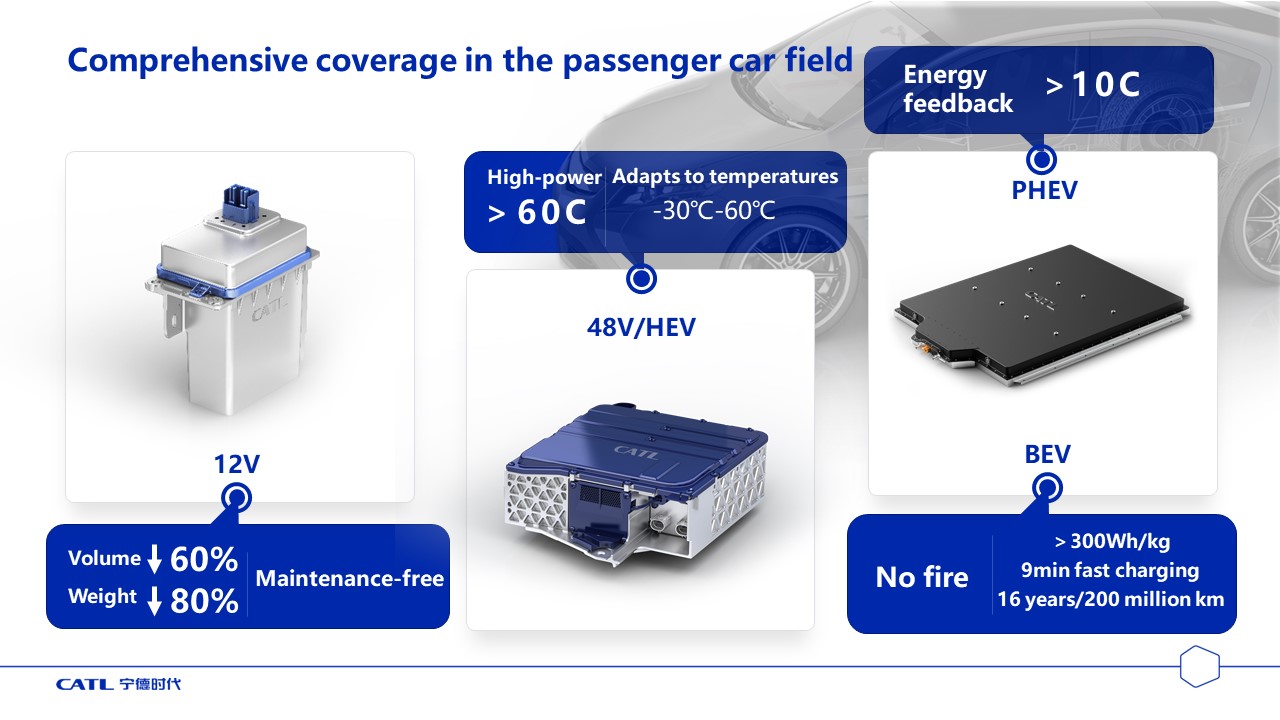
In the passenger vehicle domain, we have developed a 12-volt lithium-ion battery ACC power. Compared with lead-acid batteries, its weight and volume are reduced by 80% and 60% respectively, and the battery is maintenance-free during its lifetime. CATL 48-volt and hybrid batteries can achieve a high discharge rate of 60cycles (C). CATL PHEV batteries can achieve 10 C of braking energy recovery rate. CATL BEV batteries can help achieve a 1,000 km range, 10 minutes of fast charging, and a 16-year/2 million-km service life, which completely resolve consumers' concerns about the range, charging and life cycle of the EV battery.
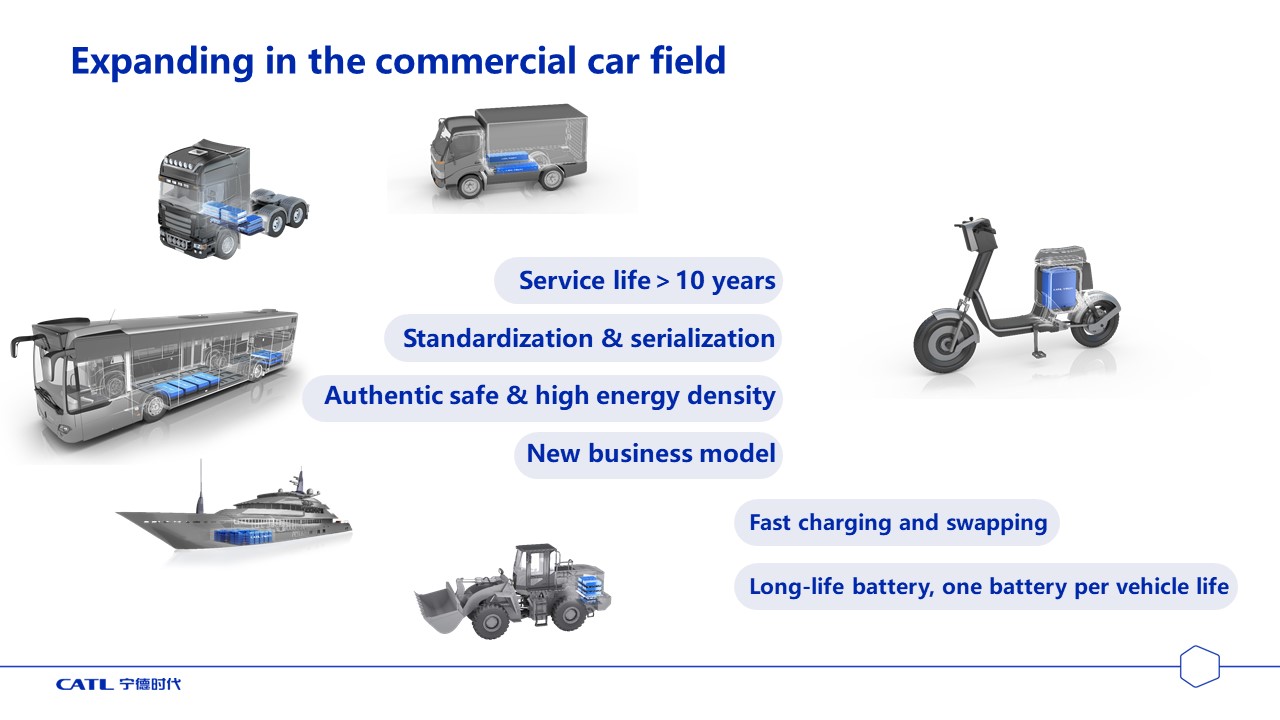
In the commercial vehicle domain, vehicles are mostly regarded as production tools with various model types. In response to this characteristic, we have developed long-life batteries to ensure quality assurance for high-intensity operations. Standardized and serialized design batteries can effectively improve versatility. In cooperation with industrial chain partners, we have developed new business models such as battery swap, battery or EV leasing etc. We also discovered that the demand on batteries of two-wheeled vehicles for household use are different from those of vehicles for delivery use. Therefore, the batteries we designed can be charged and swapped rapidly. What's more, the battery life is long enough to serve the entire life cycle of the vehicle, saving consumers the cost of replacing the battery.
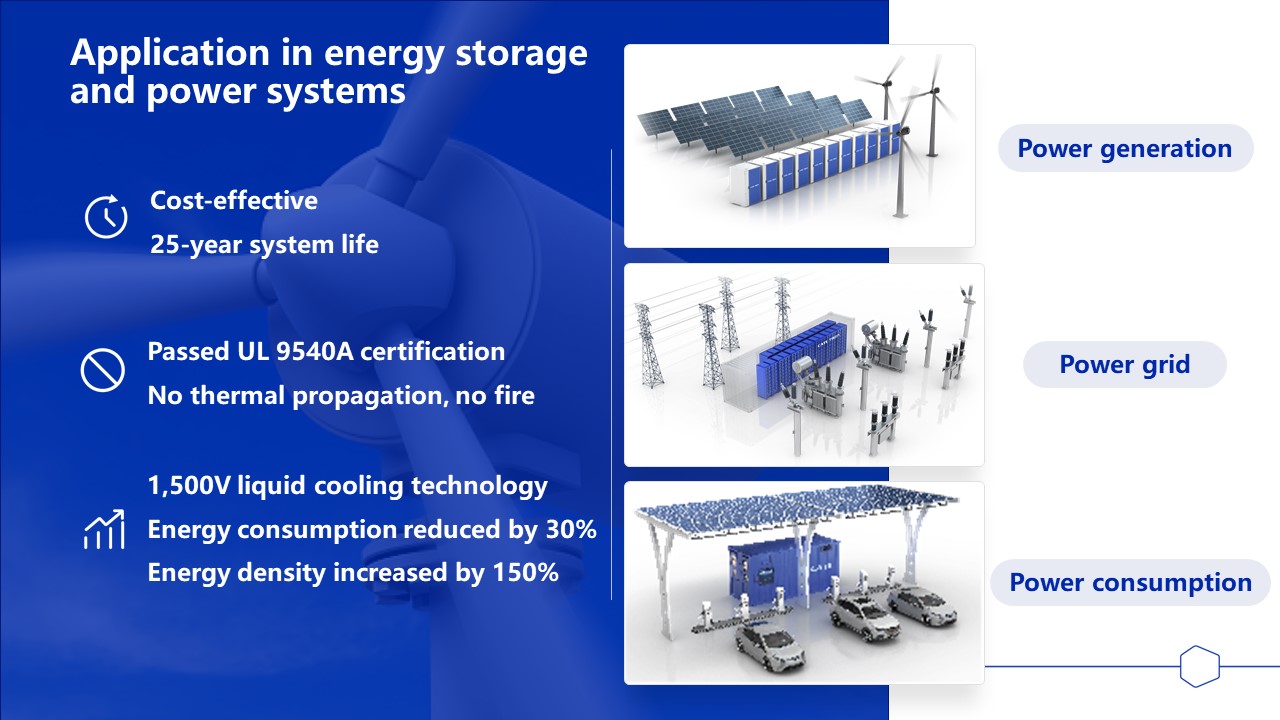
The field of energy storage has grown from the phase of R&D and demonstration into large-scale development. With the support of the Smart Grid R&D program under the 13th Five-Year Plan, we have achieved a breakthrough in the battery life cycle – an ultra-long life of 12,000 cycles lasts for 25 years for our energy storage battery. CATL took the lead in passing the UL safety test, thus developing a product with no thermal propagation and no fire when a single cell thermal runaway is initiated inside a battery system. With the application of a 1,500-volt system and liquid cooling technology, the energy density and energy efficiency of our batteries are greatly improved. In the past two years, countries overseas have provided major markets for solar and energy storage, while Chinese companies act as main suppliers. Solar power in China is also developing dramatically, but the large-scale expansion of energy storage still lacks support from policies and market mechanisms.
The market is growing rapidly and customers are making higher demands. A strong innovation system is the foundation of advanced product development and manufacturing to achieve high-quality delivery.
Through years of accumulated experience, CATL has gradually formed four innovation dimensions of "material chemistry structure system, structure system, extreme manufacturing, and business model."
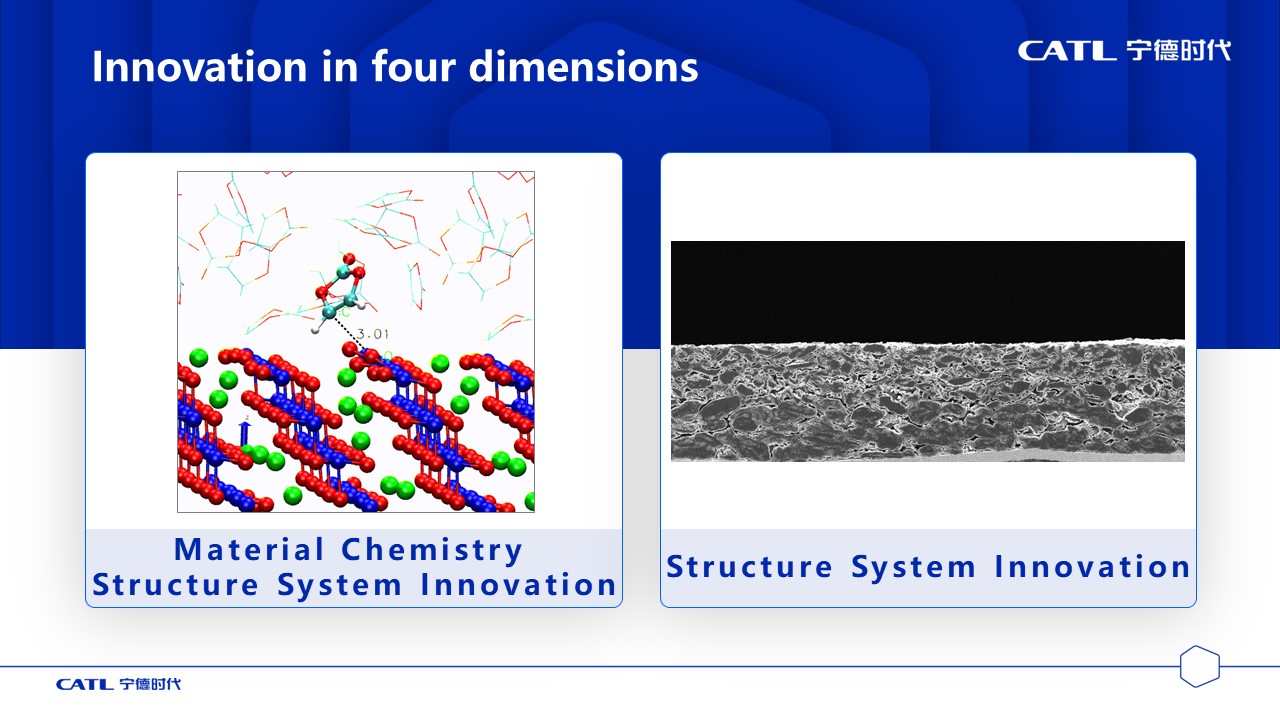
First of all, the innovation of the material chemistry structure system is vitally important. In the near future, there is potential for the development of LFP and NCM materials, which will continue to dominate the market. In the future, there might be some new chemical systems emerging, which require a deep understanding of the chemical materials and their surface from the atomic level to achieve a fundamental breakthrough in the chemical system. To meet the long-term and enormous market demand, we should avoid using precious metal materials to achieve a more cost-effective battery production.
The second is system structure innovation, including CTP (Cell to Pack), CTC (Cell to Chassis) etc., mainly by optimizing the structure system and improving integration to achieve the reduction of the system energy consumption and cost, and the improvement of efficiency.
The third is extreme manufacturing innovation. CATL is committed to achieving three goals: Firstly, the performance of the battery cell defect rate should be improved from the PPM (parts per million) level to PPB (parts per billion), which level by three magnitude orders. Secondly, to ensure the reliability of the whole battery life cycle, we should observe and understand the evolvement and the distribution from the micro perspective throughout thousands of cycles. These fundamental tasks need to be completed in a thorough manner. Thirdly, we need to significantly improve production efficiency to achieve TWh-scale production with high quality.
The fourth innovation is in the business model. From raw materials, battery manufacturing, operation service, material recycling and other procedures, it requires the formation of a complete value chain to ensure the sustainable development of the lithium-ion battery industry in the TWh era.
In addition, I would like to talk about the relationship between platformization and the differentiation of products. The comprehensive electrification of transportation and the transformation towards clean electricity are a complex process as well as a huge project, a project which relies on a standardized platform design to save resources with high efficiency.
At the same time, platformization and differentiation do not contradict each other. Take our CTP products as an example, we offer batteries with various capacities for different range requirements; with various life expectancies for different quality assurance needs. Moreover, we provide a fast battery replacement function for batteries that are used in high-intensity scenarios, V2G (Vehicle to Grid) function for low-intensity scenarios, and the technology of fast-heating in low temperatures for use in extremely cold conditions. In short, by platformized designs, we are able to provide a product matrix with different characteristics to meet the personalization and differentiation requirements.
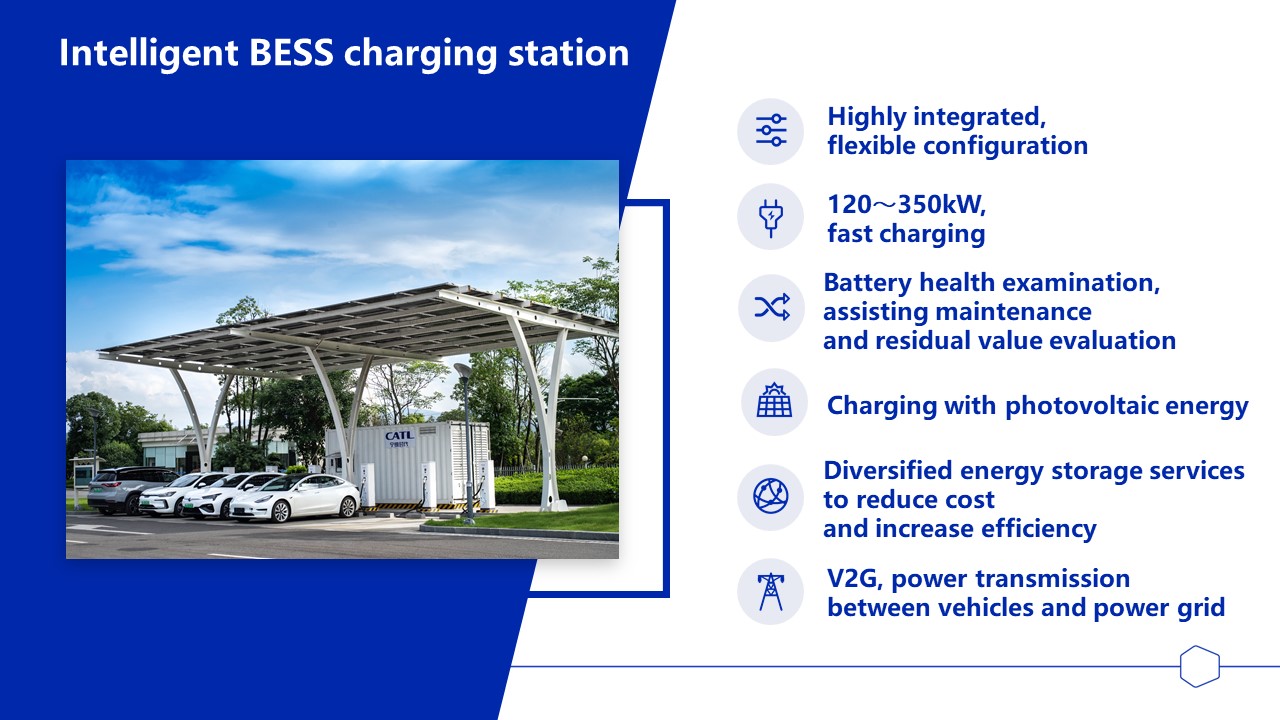
Besides, multi-function integration and overlay are also a direction we follow. For instance, we have developed the smart charging station BESS (Battery Energy Storage Solution), integrating various functions including solar power generation, energy storage, charging and battery health examination. BESS is space-efficient, allowing high-power charging without increasing power capacity. The charging station which is equipped with solar panels on its roof generates electricity for EVs. Every charging process is also an in-depth health examination for the battery, offering maintenance recommendations and residual value evaluation reports. Moreover, our energy storage solution provides add-on services such as peak and frequency regulation, as an additional profit model.
To sum up, the new energy vehicles, renewable energy, and electrochemical energy storage industries have reached an explosive inflection point, and an unprecedentedly huge market awaits. Only through fast development can we meet the market demand and maintain our leading position, as well as keep pace with the era of intelligent electrification. Boundless is the blue of the ocean where we hoist the sails. Let us work together, standing at the crest of the wave of the new era, to move faster and go further!
By clicking on the button “I accept” or by further usage of this website you express consent with usage of cookies as well as you grant us the permission to collect and process personal data about your activity on this website. Such information are used to determine personalised content and display of the relevant advertisement on social networks and other websites. More information about personal data processing can be found on this link. Read More
